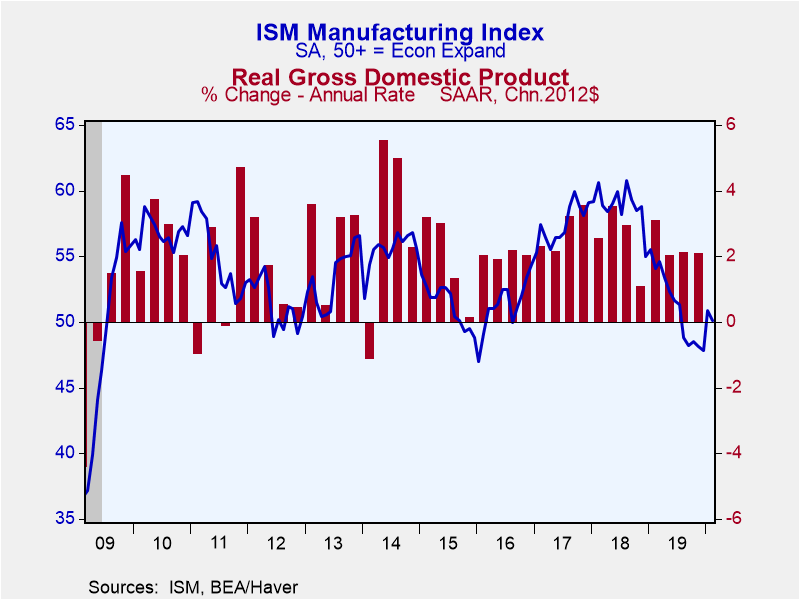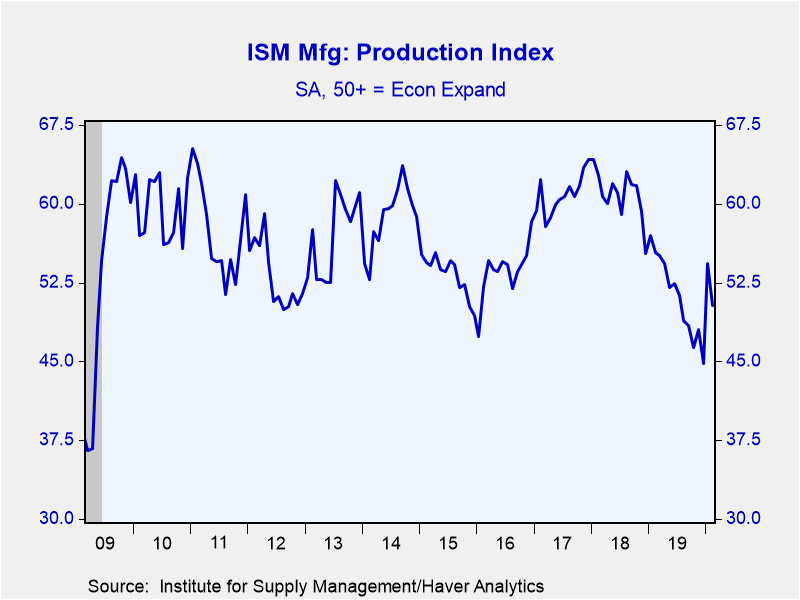 Global| Mar 02 2020
Global| Mar 02 2020ISM Manufacturing Index Weakens Slightly; Prices Decline
by:Tom Moeller
|in:Economy in Brief
Summary
• Production & new orders weakness offset by slower product delivery speeds. • Pricing power eases. Activity in the factory slowed last month. The Institute for Supply Management (ISM) reported that its composite index of [...]
• Production & new orders weakness offset by slower product delivery speeds.
• Pricing power eases.
Activity in the factory slowed last month. The Institute for Supply Management (ISM) reported that its composite index of manufacturing sector activity for February declined to 50.1 after rising to 50.9 in January. These figures nevertheless remained above the dividing line between expansion and contraction in the manufacturing sector. A reading of 50.5 had been expected in the Action Economics Forecast Survey. During the last 15 years, there has been a 68% correlation between the composite index and the quarterly change in real GDP.
The easing in the composite index reflected declines in the new orders and production components, although at 50.3 the production series remained significantly improved from 44.8 in December. The jump in the supplier deliveries reading to 57.3 from 52.9 suggested the slowest speed of product deliveries since November 2018. The inventories component fell to the low end of its recent range.
The slight rise in the employment figure to 46.9, nevertheless, continued to reflect a decline in factory sector payrolls. Twelve percent (NSA) of factory sector payrolls increased while 19% declined. During the last 15 years, there has been an 80% correlation between the index and the m/m change in factory sector payrolls.
The prices paid series fell sharply to 45.9, its lowest level since October. Seventeen percent (NSA) of survey respondents reported higher prices while 25% reported declines.
Amongst other series in the survey, the imports figure plummeted to an expansion low. The export reading slipped to 51.2 (NSA), but remained up from 47.3 in December. The order backlog index surged to 50.3, its highest level since last March.
The ISM figures are diffusion indexes where a reading above 50 indicates expansion. The figures from the Institute for Supply Management can be found in Haver's USECON database; further detail is found in the SURVEYS database. The expectations number is available in Haver's AS1REPNA database.
| ISM Mfg (SA) | Feb | Jan | Dec | Feb'19 | 2019 | 2018 | 2017 |
|---|---|---|---|---|---|---|---|
| Headline Index | 50.1 | 50.9 | 47.8 | 54.1 | 51.2 | 58.9 | 57.4 |
| New Orders | 49.8 | 52.0 | 47.6 | 54.9 | 51.1 | 61.6 | 62.1 |
| Production | 50.3 | 54.3 | 44.8 | 55.4 | 51.2 | 60.9 | 60.9 |
| Employment | 46.9 | 46.6 | 45.2 | 53.2 | 50.9 | 56.9 | 56.8 |
| Supplier Deliveries | 57.3 | 52.9 | 52.2 | 55.3 | 52.9 | 62.0 | 56.8 |
| Inventories | 46.5 | 48.8 | 49.2 | 51.6 | 49.8 | 52.9 | 50.4 |
| Prices Paid Index (NSA) | 45.9 | 53.3 | 51.7 | 49.4 | 49.1 | 71.7 | 65.0 |
Tom Moeller
AuthorMore in Author Profile »Prior to joining Haver Analytics in 2000, Mr. Moeller worked as the Economist at Chancellor Capital Management from 1985 to 1999. There, he developed comprehensive economic forecasts and interpreted economic data for equity and fixed income portfolio managers. Also at Chancellor, Mr. Moeller worked as an equity analyst and was responsible for researching and rating companies in the economically sensitive automobile and housing industries for investment in Chancellor’s equity portfolio. Prior to joining Chancellor, Mr. Moeller was an Economist at Citibank from 1979 to 1984. He also analyzed pricing behavior in the metals industry for the Council on Wage and Price Stability in Washington, D.C. In 1999, Mr. Moeller received the award for most accurate forecast from the Forecasters' Club of New York. From 1990 to 1992 he was President of the New York Association for Business Economists. Mr. Moeller earned an M.B.A. in Finance from Fordham University, where he graduated in 1987. He holds a Bachelor of Arts in Economics from George Washington University.










